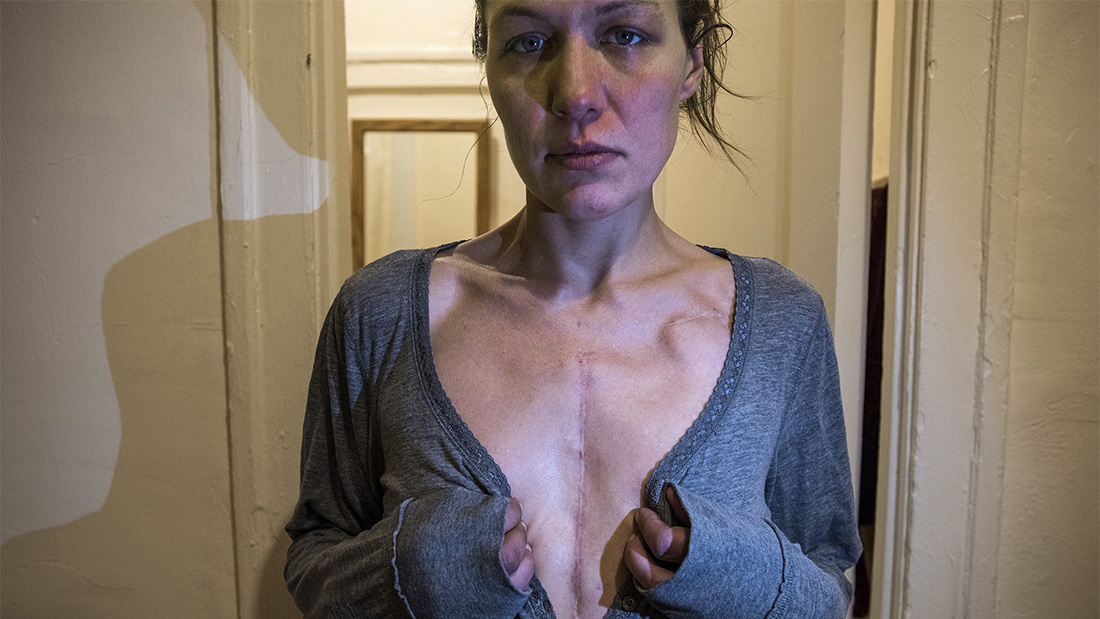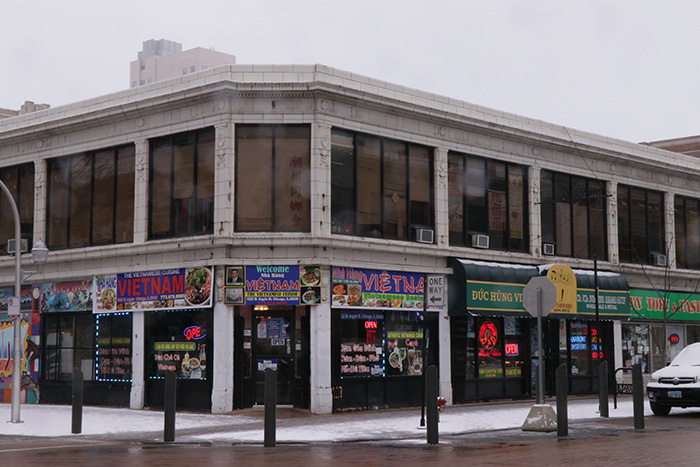By Lu Zhao
Medill Reports
The single room occupancy (SRO) residence on Kenmore Avenue occupies a clean, quiet and lovely part of Uptown, dotted with a chain of Vietnamese and Chinese shops.
The building is close to the Argyle station on the Red Line, only a three-minute walk away.
I wasn’t sure whether I could find Mary at the SRO. She doesn’t have a phone and often goes out panhandling. Luckily, I ran across her at the elevator as she was heading to find her boyfriend Tom. They hadn’t seen each other for three days.
Mary, 30, came from St. Louis with him last June. Hoping to find more job opportunities in Chicago, they didn’t make it and then ran out of money. Panhandling on the street and living in a small shack became their life. Then Mary’s heart condition and an amputated finger made her eligible to move into the SRO, one of the 168 rooms in the dwelling, in January.
We climbed stairs to the second floor where she lives. The old elevator that rattles upward doesn’t stop at the second floor. Besides, it shuts down from 12:30 a.m. to 6:30 a.m., Mary told me.
“I don’t think those are good five years,” she pointed at the certification of the elevator on the wall, which was signed five years ago.
The mixed smell of cigarettes, food and beer lingers in the hallway. Many smokers and alcoholics live here, Mary said.
She lives in a room around the corner of the main hall, a room somewhat bigger than others, with a bathtub in a private bathroom.
Her room is super warm so that Mary has to keep her window slightly open. She couldn’t wait to take off her heavy clothes: aviator hat, snow boots, layers of socks and clothes. The old radiator can’t be adjusted for temperature but Mary felt blessed to have a heated room. She used to need layers of blankets to keep warm that she literally couldn’t lift them.
“The heat is kind of luxury because I didn’t have that before,” Mary said.
A twin-sized bed, chair, drawer, refrigerator, heater, closet and bathroom. These are typically what you get in a single room occupancy (SRO unit). It may be simple but it can be a good start for homeless people.
With her light brown hair pulled into a ponytail, her freckled face and deep grey eyes, she looks like a 20-year-old girl. She seems gentle and full of happiness when she smiles. But she cries every day, Mary told me. She wants her life to change.
Getting the room was a big accomplishment for Mary, and she hopes it’s the start of turning her life around. Yet the room was achieved at the cost of her health and, still, just surviving and keeping her spirits up is a daily struggle for her.
Mary got this temporary housing through a hospital program called Better Health through Housing. She had open-heart surgery before she came to Chicago and was in the University of Illinois Hospital & Health Sciences System (UI Health) last October for almost a week. A surgeon there amputated the middle finger of her left hand due to an infection.
Better Health through Housing, a partnership with the Center for Housing and Health (CHH), was launched by UI Health in 2015. Patients who have chronic health conditions and are homeless, like Mary, are identified by UI Health. They are referred to CHH who contacts other organizations to provide case managers and housing sources. UI Health has settled about 50 people so far, said Sharon Parmet, the associate director of UIC News Bureau.
The agency that contacted Mary was Heartland Alliance, a non-profit organization aims at ending poverty. It took her about two months to get into the SRO unit, which is temporary, optional and free, providing a transition to get a permanent apartment. She might stay in the SRO unit and wait for another two or six weeks, according to Mary’s case manager.
Yet it is not easy to get in contact without a phone. Mary hasn’t met any case manager since she moved in.
A cell phone is what Mary needs now, she said. She needs to stay in touch with her case manager, get in touch with Tom, schedule appointments, and she doesn’t even know the time when she wakes up. Often, she has to dress up and go downstairs to check the clock there.
“I can use a phone to find several different resources that can benefit me and I can utilize right now that I do desperately need,” Mary said fast and eagerly. “But I can’t really do that.”
Without a phone, radio and television, staying in her room is nice but boring, Mary said. She is not allowed to have visitors during the first month, under the building’s rules. After that, she can only have one visitor per day through 9 a.m. to 9 p.m. and one overnight visitor per month. That means Tom can only meet her for short times outside of the room during the first month, which is nearly over, and can’t live with her in the room even after that.
“It’s kind of odd to me that they say you can’t have visitors,” Mary said.
The rules also say no televisions though Mary can hear them everywhere.
“Some people keep the televisions aloud and even talk over the televisions,” Mary said, sometimes she can even hear the noise from the other end of the hallway.
The only “sanity” for Mary in this building, she said, is probably Ryan Ali, who was also homeless. She often goes to the sixth floor where Ryan lives and talks to him for a while.
“It’s nice to have someone to talk to about your day before you go back to the white walls,” Mary smiled.
Mary was once given two pieces of pizza on the street but the pizza got frozen after one day outside. She doesn’t have a microwave in her room yet but Ryan has one. She went to Ryan’s room and heated the pizza.

Ryan was also enrolled in the program when he was in the hospital. He has been to the emergency room 13 times because of his infected legs. He got the infection five years ago and the tissue around the wound has deteriorated and developed into an open laceration.
“It’s a nice place to be … as far as my legs, I may lay down and rest and change bandages,” Ryan said. “They’re getting better now.”
The two months after Ryan left the hospital and waited to get a room was probably the toughest time that he has ever experienced, he said.
Though his room is slightly smaller than Mary’s, it doesn’t bother him. Ryan sometimes goes to talk with his neighbor, who shares the bathroom with him and is clean and nice, he said.
Safety is what both Mary and Ryan treasure in the SRO and the neighborhood.
“It’s heated and I’m safe,” Mary said, adding that she feels grateful about the room. “I know nothing is going to happen to me up here.”
Besides housing, Mary has another plan to improve her health. She is going to a methadone clinic this month when her new insurance takes effect.
“I’m really looking forward to that,” Mary said. “I just want to be able to have the structure, to function, to have a routine every day.
Housing is a good start, she said.
Mary asked that she and Tom not be identified by their real names for this story.





